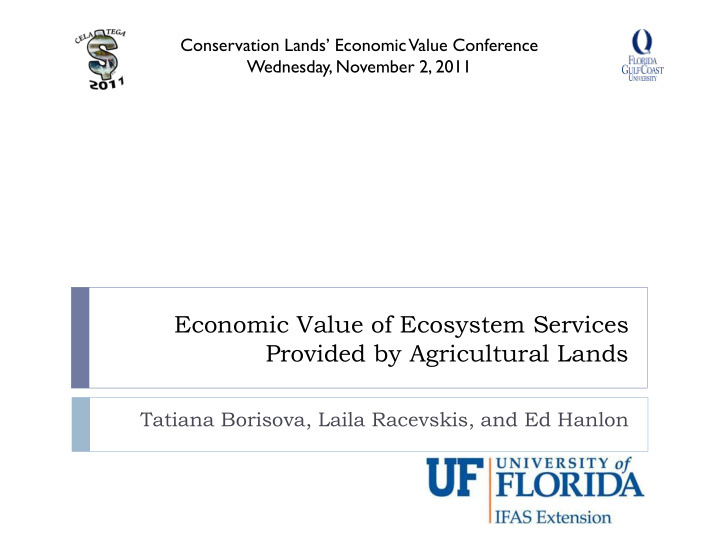



Conservation Lands’ Economic Value Conference Wednesday, November 2, 2011 Economic Value of Ecosystem Services Provided by Agricultural Lands Tatiana Borisova, Laila Racevskis, and Ed Hanlon
Florida Public Survey (2008 – 2009) How important are the following actions in protecting our water resources? Not important / No opinion Important or Somewhat Very Important important Improving 9% 5% 86% agricultural practices Preserving 9% 5% 86% agricultural lands and open spaces Borisova, Brett, and Gardner. 2010. UF EDIS Publications #FE841 - FE842 2
Photo by Carlton Ward, Jr. 3
Amenities, Services, and Products Provided by Agricultural Lands Aspects Amenity, service, or product Source: Based on Agrarian cultural Maintenance of the “traditional” agricultural character of the land Hall et al. / heritage Continuation of farming as a way of the life in the rural community Journal of New agricultural Farm produce / organics and other niche products / added value farm food economy (cheeses, etc.) Rural Local and regionally produced food Studies Farm shops / farmers markets (2004) Traditional Food quality (taste and nutritional value) agricultural Adequate supply of food economy “Cheap” food Agricultural / relate employment Income from agricultural exports Farm incomes Environmental Farmland landscape Farmland habitats Biodiversity – species associated with agriculture Rural leisure Walks in pastoral settings activities Visiting local farms Cultural / Amenity Agricultural landscape Farm-based educational activities 4
Ecosystem Services to and from Agriculture Source: Swinton et al. / Ecological Economics (2007) 5
Producers’ actions can increase or decrease the provision of ecosystem services Environmental Service Farm-Level Management Option Carbon sequestration in soils Manage soil organic matter Carbon sequestration in perennial plants Convert cropland to grassland or forest Methane emission reduction Capture and destroy methane from animal waste storage structure Water quality maintenance Reduce agricultural use, establish vegetable buffers, and improve nutrient management Erosion and sediment control Manage soil conservation and runoff, and increase soil cover Flood control Create diversions, wetlands, and storage ponds Salinization and water table regulation Grow trees and manage Wildlife Protect breeding areas and wild food sources, improve timing of cultivation, increase crop species / varietal diversity, and reduce use of toxic chemicals Ribaudo et al. / Ecological Economics 69 (2010) 6
Ecosystem Services to and from Agriculture Markets for most ecosystem services have generally not developed Hard to measure the total value of ecosystem services to the society No reward for agricultural producers to provide ecosystem services 7
Methods for Valuing Ecosystem Services Travel cost method : Our travel plans to a sight (and our travel expenses!) depend on the site’s ecosystem service provision Contingent valuation : surveying people about their willingness-to-pay / accept payment for changes in ecosystem services Hedonics : changes in property prices due to changes in ecosystem service provision Replacement costs methods : http://www.kylandsales.com/StanfordFarm/StanfordFarm.html costs of mitigating / replacing the service Factor-income approach : link ecosystem services to the incomes from agriculture 8 Source: Swinton et al. / Ecological Economics (2007)
Example : Value of Agricultural Easement in Howard and Calvert Counties, Maryland • Geoghegan et al. / Agricultural and Resource Economics Review (2003): Hedonic price • method http://www.mainefarmlandtrust.org/ 9
Example : Recreational benefits from conservation tillage (Corn Belt) Conservation tillage reduces erosion- based pollution => greater enjoyment of water-based recreation Travel cost method 2 levels of adoption of conservation http://nfrec.ifas.ufl.edu/programs/impacts_conservat tillage (based on 2002 Farm Bill ion_tillage.shtml projections) Water-based recreational benefits: $175.5 – 242.6 million / year Baylis et al. / Review of Agricultural Economics (2002) 10
Incentives for Ecosystem Service Provision Range of approaches traditionally used by government agencies Financial and technical assistance Regulations Education Market-based mechanisms can be more efficient Farmers have the flexibility to chose the practices to supply ES based on their private information and price signal 11 Ribaudo et al. / Ecological Economics 69 (2010) http://environmentalheadlines.com/ct/2010/09/20/aft- %E2%80%99s-releases-state-level-agricultural-easement-stats/
Existing markets for supplying ecosystem services from agriculture Emission trading Greenhouse gas trading Water quality trading Wetland mitigation Eco-labeling 12 Ribaudo et al. / Ecological Economics 69 (2010)
Market-based Policy Mechanisms: Challenges Measuring the performance of agricultural management practices Lack of cost of information Transaction costs of bringing together buyers and sellers Coordinating federally- and state-funded conservation programs with market-based programs http://www.nevadacountylandtrust.org/index.php/lands/working-land- easements/agriculture-easements/ 13 Ribaudo et al. / Ecological Economics 69 (2010)
VisitFlorida.com Conclusions Agriculture provides a range of ecosystem services that are valued highly by society Policy mechanisms are needed to provide incentives to the farmers to provide ecosystem services A range of policy instruments can be used, each with advantages and disadvantages Research needs for Florida: Value of ecosystem services Determinants of the farmers’ decisions to “supply” ecosystem services Policy instruments and producers ’ level of participation 14
Thank you! Questions? Dr. Ed Hanlon, Dr. Tatiana Borisova, Dr. Laila Racevskis, Soil and Water Science, Food and Resource Food and Resource Southwest Research Economics Department, Economics Department, and Education Center, University of Florida University of Florida University of Florida (352) 392-1826 ext. 317 (352) 392-1826 ext. 324 (239) 658.3400 tborisova@ufl.edu racevskis@ufl.edu eahanlon@ufl.edu 15
Recommend
More recommend